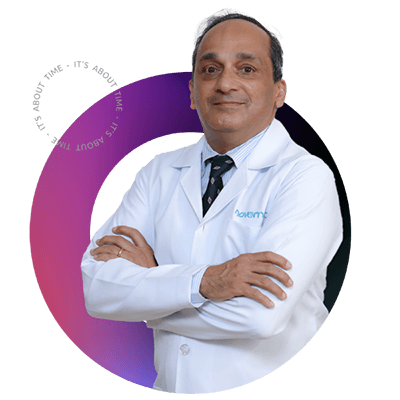Obstructed Defecation Syndrome (ODS) is a condition that affects the ability to have a regular bowel movement, causing the inability or incomplete evacuation of stool. ODS requires proper understanding and management because it can lead to significant discomfort and impact a person’s quality of life. The condition is often linked to lifestyle factors, pelvic floor dysfunction, anorectal disorders, or functional abnormalities.
Obstructed Defecation Syndrome can be effectively managed through dietary and lifestyle modifications, pelvic floor rehabilitation, medications, and occasionally surgical interventions. People with ODS can significantly reduce their symptoms and regain a better quality of life with the appropriate treatment.
What are the symptoms of obstructed defecation syndrome?
ODS can cause various symptoms, which usually include:
- Difficulty passing stool or feeling of incomplete evacuation.
- Excessive straining during bowel movements.
- Frequent episodes of constipation.
- A feeling of a blockage or obstruction in the rectum.
- Rectal or pelvic pain.
- The need to use your finger to help pass stool.
- Abdominal bloating and discomfort.
What are the causes of obstructed defecation syndrome?
Several factors can lead to Obstructed Defecation Syndrome, including:
- Pelvic floor dysfunction: Maintaining bowel function depends heavily on the pelvic floor muscles. ODS might be exacerbated by weakness, pelvic floor muscle imbalances, or coordination problems.
- Anorectal disorders: Stool passage can be obstructed by conditions such as internal rectal intussusception (rectal telescoping), rectal prolapse (protrusion of the rectum through the anus), and rectocele (rectum bulges into the vagina).
- Functional abnormalities: ODS may be exacerbated by abnormalities in colonic transit (the passage of stool through the colon), diminished rectal sensation, or problems with colon-rectum coordination.
- Lifestyle factors: Constipation and ODS can be caused by poor dietary habits, insufficient fluid intake, sedentary behavior, and a lack of physical activity.
What are the risk factors for Obstructed Defecation Syndrome?
- Age: Middle-aged and older people are more likely to have ODS.
- Gender: Due to variables like childbirth, hormonal changes, and pelvic floor issues, women are more vulnerable to ODS than men.
- Pregnancy and childbirth: For certain women, the stress pregnancy and childbirth place on the pelvic floor muscles might result in ODS.
- Chronic constipation: Long-term or chronic constipation is a significant risk factor for ODS.
- Sedentary lifestyle: By reducing muscle tone and bowel motility, a sedentary lifestyle and insufficient physical activity might exacerbate ODS.
- Previous pelvic or rectal surgeries: ODS risk may be affected by prior pelvic or rectal procedures, such as hemorrhoidectomy or rectal prolapse repair.
How is obstructed defecation syndrome diagnosed?
To diagnose obstructed defecation syndrome, the proctologist will review your medical history and perform a rectal examination to assess the strength and function of the pelvic floor muscles. They may order imaging tests such as X-rays, defecography (barium study), or dynamic MRI scans to examine the anatomy and functioning of the rectum and pelvic floor. These tests provide valuable information on muscle function and any structural abnormalities.
The proctologist may also perform an anorectal manometry test, which measures the pressure and coordination of the anal and rectal muscles during bowel movements, to examine the functionality of the pelvic floor and rectum. Additionally, a colonoscopy or sigmoidoscopy may be performed to rule out other causes of bowel obstruction.
How is obstructed defecation syndrome treated?
1. Dietary changes: Improving bowel regularity and preventing constipation can be achieved by increasing dietary fiber intake, drinking enough water, and adopting a well-balanced diet.
2. Regular physical activity: Walking or running regularly can encourage bowel movements and relieve constipation, which is why you should aim for 30 minutes of physical activity daily.
3. Pelvic floor rehabilitation: Rehabilitation of the pelvic floor is essential in the treatment of ODS. The pelvic floor muscles will be strengthened and coordinated through the use of exercises and techniques such as:
- Pelvic floor exercises (Kegel exercises): These exercises involve contracting and relaxing the pelvic floor muscles to increase their strength and coordination.
- Biofeedback: This method helps people learn to manage and develop their pelvic floor muscles using specialized devices to offer visual or auditory feedback on muscle activity.
- Electrical stimulation: In this technique, the pelvic floor muscles are stimulated using low-intensity electrical currents to improve their coordination and function.
4. Medications: In some cases, doctors may recommend medications to treat underlying causes or symptoms associated with ODS. The specific medication prescribed depends on individual factors and may include:
- Laxatives: These medications relieve constipation by softening the stool and encouraging regular bowel movements.
- Stool softeners: Like laxatives, stool softeners work by softening the stool to make it easier to pass.
- Medications for improving bowel motility: These medications encourage bowel movements by increasing intestinal muscle contractions.
5. Behavioral changes: Developing healthy bowel habits, such as going to the bathroom regularly and avoiding excessive straining, can help manage symptoms.
6. Surgical interventions: Surgical interventions may be considered if conservative treatments are ineffective or if underlying structural abnormalities are causing ODS. Surgical options include:
- Rectal prolapse repair: This surgery is performed to correct a rectal prolapse, a condition where the rectum protrudes through the anus and causes obstruction.
- Rectocele repair: In cases where a rectocele (the protrusion of the rectum into the vagina) is causing obstruction, surgery can be done to restore normal function.
- Sphincter repair: Surgery can be performed to strengthen or repair the anal sphincter muscles if they are weak or damaged, which can improve bowel function and control.
Schedule your appointment at Novomed today!
If you are experiencing symptoms of Obstructed Defecation Syndrome, contact our expert proctologist in Dubai by calling toll-free 8006686 to manage your condition effectively.


























